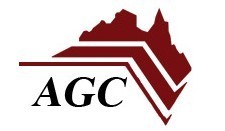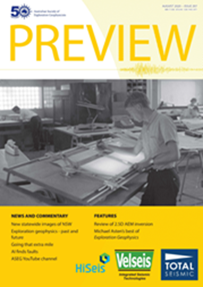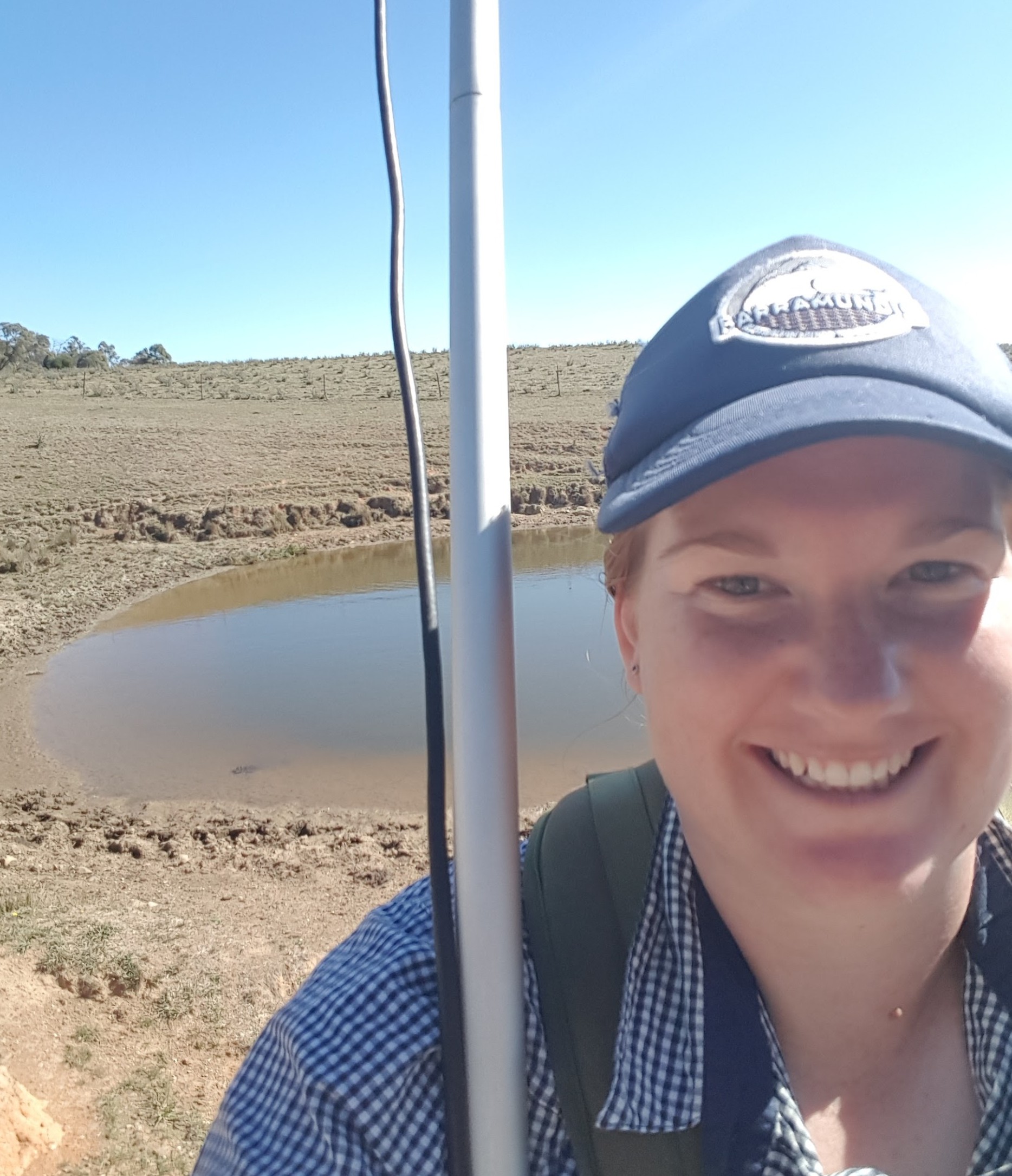|
For optimal viewing, we recommend you view this newsletter in your browser, click here
ASEG Newsletter | Issue 29 | August 2020
Dear Members,
In the August Newsletter you will find on:
Thank you Archimedes Financial
AGC Indigenous Scholarship
Words from Roger - An advantage of COVID-19
PhD Scholarships at Curtin University
AEGC 2021 - Short abstract submission opening on 2 Sept
SEG-Live - New Virtual Offerings Launched
ASEG YouTube
ASEG Research Foundation- Projects supported in 2020
And of course, our regular articles.
For updates on upcoming webinars, events and interesting articles follow ASEG on LinkedIn, twitter and facebook.
Thank you Archimedes Financial
The ASEG would like to thank Archimedes Financial for their long-standing support as a Corporate Member. After over 30 years in the industry, their principal, Noll Moriarty has decided to retire. Noll was a board member of the ASEG Federal Executive between 1996 and 1998 and was elected President in 1998. Despite slowing down to pursue Spanish, a long-standing passion, Noll assures us that he will likely be seen at future conferences.

AGC Indigenous Scholarship
 The Australian Geoscience Council (AGC) is offering a scholarship to provide financial support of $5000 per annum for a full time student to finish their undergraduate degree. The scholarship is available to those Indigenous students who have completed at least the first year of their university course and intend on majoring in a field of Geoscience. For more information, visit the AGC Website. The Australian Geoscience Council (AGC) is offering a scholarship to provide financial support of $5000 per annum for a full time student to finish their undergraduate degree. The scholarship is available to those Indigenous students who have completed at least the first year of their university course and intend on majoring in a field of Geoscience. For more information, visit the AGC Website.
Words from Roger - An advantage of COVID-19
Some words from ASEG Member, History Committee Chair, Roger Henderson
There is one advantage of the current pandemic that is useful to geophysicists. It has been observed that the normal background 'noise' on seismographs usually attributed to human activity; traffic noise, industrial activity, etc., is much reduced during this period of enforced 'lockdowns'.
A study reported in Science* analysed 185 seismic stations around the world and found a sudden and significant lessening of seismic noise of up to 50%, particularly in the 4-14Hz high frequency range. This occurred throughout Europe in March and April of this year. The reduction in noise was greater than as usually occurs in the Christmas/holiday period.
As a result, the much clearer records allow studies of them to be more accurate, such as for determining epicentres. Potentially, they may also allow the detection of minor ‘quakes, otherwise buried in the noise.
Furthermore, geophysical methods using normal passive seismic energy may be improved except if they rely on frequencies in the noise range.
The full paper for this information is: Science, DOI:10.1126/science.abd2438.
PhD Scholarships at Curtin University
There are several RTP PhD projects available at Curtin University. Applications close 1 September 2020, so if interested get in contact with Boris Gurevich. For information on projects, visit the Curtin University website. Potential topics include; Investigation of the Australian crater record, Machine Learning for Hydrogeological Applications, Geophysical Imaging Technologies for Lunar, Asteroid and Planetary Exploration, Earth and Planetary Remote Sensing, utilising Dark Fibre with Artificial Intelligence to Assist The Smart City Concept, Tectonic controls on Triassic sedimentation, NW Shelf, Australia, See invisible: Digital Rock Under Stress, Nuclear Geophysics and Monitoring CO2 flow in the subsurface using FO sensing.
AEGC 2021 - Short abstract submission opening on 2 Sept
The short abstract submission for AEGC 2021 will open Wednesday 2 September. AEGC 2021 will be held at the Brisbane Convention & Exhibition Centre (BCEC) on 15-20 September 2021, under the conference theme of 'Geoscience for a Sustainable World'. Further information on guidelines and how to submit can be found on the AEGC website.

SEG-Live - New Virtual Offerings Launched
SEG are continuing to expand their education offerings, with additional courses between 19 September and 30 October at budget-friendly prices. Visit SEG Live for more opportunities.
ASEG YouTube
All our ASEG Webinars are available on the ASEG Website and ASEG Youtube. Subscribe to the ASEG YouTube channel to be kept up to date with the latest videos. Highlights from August’s talks are listed below.
ASEG Research Foundation - Projects supported in 2020
The ASEG are committed to supporting our students and research community, and are thrilled to announce the four recipients of the ASEG Research Foundation grants. The four recipients, titles and project summary are included below for you reading pleasure. For more information visit the ASEG Website.
Geophysics in Precision Agriculture: Mapping Soil Properties to Guide Amelioration Practises in the WA Wheatbelt
Natalia Delgado, student at University of WA
Supervisor - Professor Mike Dentith
Summary - Geophysics is increasingly used in precision agriculture to map soil properties to facilitate optimal economic and environmental management of the land. New and existing geophysical data from a test site near Badgingarra, WA will be used to map soil properties in 3D. Methods which will be used include radiometrics, frequency-domain EM and GPR. The primary aims of the research are to determine how to best map clay content and depth to hard horizons. This information is crucial for determining which areas will benefit from tillage to counter water repellancy of the top soil and compaction of the sub-soil.
Comparison, evaluation, and optimisation of the portable near surface Loupe TEM system for underground Nickel sulphide detection
Fionnuala Campbell, student at Curtin University
Supervisor – Professor Brett Harris
Summary - The project aims to determine the Loupe Electromagnetic (EM) System’s ability to detect and accurately map Nickel sulfides in an underground mine environment. The Loupe EM System will be directly compared to a conventional fluxgate-surface loop EM survey. This will be compared primarily based on resulting 1D conductivity models. An in-depth evaluation of the Loupe EM System in a new and potentially high value environment has a potential high value for industry. If successful, the Loupe System could reduce the cost, time and personnel required for conventional EM surveys. The Loupe EM System is expected to accurately detect the underground sulfides to a comparable or better quality than conventional fluxgate surface loop EM survey methods.
Controls on gravity-driven normal fault geometry and growth in stacked deltaic settings
Monica Jimenez Lloreda, student at University of Adelaide
Supervisors – Assoc Professor Simon Holford, Assoc Professor Ros King and Dr Mark Bunch
Summary - The Ceduna Sub-basin is a superb natural laboratory for studying the evolution of normal faults in stacked deltaic settings with multiple detachments. This project aims to increase our understanding of normal fault growth in deltaic continental margin successions, and more clearly define the role played by faults in determining trap configuration within the Ceduna Subbasi. Through detailed interpretation of extensive 3D seismic data, the expected outcomes of this project include new models for fault growth and the evolution of structural domains, associated workflows for the interpretation of syn-kinematic listric faults, and the identification of trapping structures within the Ceduna sub-basin that might be at risk of reactivation.
Title - Assessing a multi-modal approach in the location of unmarked graves under various seasonal conditions
Andrew Frost, student at Flinders University
Supervisor - Dr Ian Moffat
Summary - Australia is a dry continent. As such, the soil tends to be dry, and this affects the suitability and effectiveness of common geophysical techniques in the location of unmarked graves. This research will focus on the role that soil grain structure and moisture levels play. The suitability of the Schmidt (2017) precipitation ratio will be assessed for translation to the dryer Australian conditions, along with grain size and composition being assessed by using X-Ray diffraction, and soil permittivity will be explored. Three test sites have been identified, with one test site containing graves that were dug by the researcher in the late 1980's, this is believed to be a world first.

Follow our social media pages to stay up-to-date with the latest talks. Past talks can be found on the ASEG Videos Page.
Recommend a talk suggestion? Email communications@aseg.org.au.
ASEG Webinars
SEG Webinars
The SEG are hosting a range of Webinars that are free to attend but require pre-registration.

Branch upcoming events
Due to COVID19 all in-person state branch activity has been suspended. Details about future ASEG Branch events can be found on the ASEG website.

For a more complete calendar of events see Preview
| Date |
Event |
|---|
| 11-16 October, 2020 |
SEG 2020 Annual Meeting, Houston, Texas
|
| 7-11 December, 2020 |
AGU Fall Meeting, San Francisco, California
|
| 8-11 December |
82nd EAGE Annual Conference and Exhibition, Amsterdam, The Netherlands.
|
| 25-27 May 2021 |
AustMine, Perth, Australia
|
| 15-20 September 2021 |
AEGC 2021, Brisbane, Queensland
|

ASEG members can access Exploration Geophysics articles free of charge by logging into the ASEG website and navigating to Professional > Publications > Exploration Geophysics.
Hi all avid Exploration Geophysics readers,
Issue 4 is now out, please have a look as there are some great papers to read. I recommend the paper by Ted Lilley on the phase tensor analysis of Magnetotelluric data as a must read paper.
From the recently published online papers... I suggest the paper by Dong et al on full waveform inversion and the paper by Li et al on a noise reduction method for spectrum induced polarisation data
Cheers and interesting reading,
Dr Mark Lackie
Exploration Geophysics Editor
Mark.Lackie@mq.edu.au

The August issue of Preview is now available online
This issue, the third issue of Preview since the "Rona" upended our lives, is a bumper issue - especially for those of you who have gone back into lockdown.
Our "best of" series, marking the 50th anniversary of the establishment of the Australian Society of Exploration Geophysicists, continues with a selection made by Professor Michael Asten. We also have a second feature, a review of 2.5D AEM inversion written by Rod Paterson at Intrepid Geophysics. This review sounds a timely warning about non-expert interpretation of CDIs and 1D inversions. As if two features weren’t enough, we have a third. Ken Witherly was prompted by Richard Schodde's PDAC 2020 talk to reflect on the past and future of exploration geophysics. A thought provoking analysis.
But wait, there is more, John Standley and Phil Schmidt have written a tribute to Ron Green, who is celebrating his 90th birthday in this COVID year. Happy Birthday Ron!!
 |
Also, David Denham (Canberra observed) considers the good, the not-so-good, the bad and the very bad in Canberra politics. Mike Hatch is intrigued by geophysics being carried out by archaeologists in the UK. Terry Harvey (Mineral geophysics) urges geophysicists to go that extra mile when reviewing and reprocessing legacy data. Mick Micenko (Seismic window) is pleasantly surprised by AI. Tim Keeping (Data trends) alerts readers to planning for a new petrophysical sampling guide, and calls for input to the formulation of a universal passive seismic data format, and Ian James (Webwaves) provides guidance on the use of the ASEG YouTube channel. |
Proposed contributions for future issues can be submitted by email to the editor at previeweditor@aseg.org.au
Lisa Worrall
Preview Editor
PreviewEditor@aseg.org.au

Our Member Spotlight is defying all covid restrictions and travelling up the eastern coast of Australia to Maitland where we meet Steph Hawkins, a graduate at the Geological Survey of New South Wales.

Photo: Out in the field - Steph Hawkins collecting ground magnetics over dykes near Oberon, NSW.
- What is your current role?
I am a graduate geoscientist with the Geological Survey of New South Wales in their Maitland office. As a grad, I get to rotate through all of the sections and do a bit of everything. In the geophysics sphere, I’ve participated in the AusLAMP data collection with Geoscience Australia. I spent a week and a half travelling from Newcastle to Canberra to Cobar, Tilpa, Bourke, Nynga, Coonamble and back to Maitland, collecting and deploying the magnetotellurics equipment. I’ve also been assisting with the interpretation of the AEM survey flown over the Cobar MinEx CRC area.
- If you weren't a geophysicist what would you be?
An archaeologist. I also have an ancient history degree that I completed alongside my science degree. I've been fascinated by science and history for as long as I can remember, so was one of the ways I could have combined the two passions. I watched a lot of Time Team (hosted by Tony Robinson) as I was growing up and finding what was buried underground from thousands of years ago sounds like so much fun. You can also apply a lot of science, especially geoscience, to archaeology too! Including age dating and material provenance.
- What reaction do you mostly get when you tell someone that you are a geophysicist?
A what? / What's that? / Oh, so you're really good at maths? / You must be really smart then / Rocks? You work with rocks? / Do you work in a mine?
- Do you think AI will take over your job or will the human element remain vital to exploration successes?
No. It may change parts of my job quite significantly. We'll always need the human side, to quantify the results that AI generates for us. We will need people to fix and maintain the AI and teach it all the things we want it to find.
- What's your most treasured textbook?
Geophysics for the Mineral Exploration Geoscientist by Dentith and Mudge. It just covers everything that I've ever needed.
- Your funniest or worst field memory?
Whilst doing fieldwork for my Masters, there were times where it was a hilarious, constant battle to stop the sheep on the farm from eating the tape measures we were using. I remember turning around and just being completely surrounded by sheep. Avoiding cow pats was another funny part of the fieldwork, you could be guaranteed the only place they'd be was exactly where I needed to take a magnetic reading.
- What aspect of geophysics do you enjoy most?
I enjoy that I am always learning and that there is so much to learn about geophysics. There is always something new and technologies are always changing. We are getting better resolution data or more computer power to process previously collected data. It's exciting seeing machine learning and more data science being worked in all geoscience.
- Where was your best sunrise/sunset location?
Best sunset on the London Eye in the middle of summer, after a classic English rainy day. The sun had come out for the evening and setting amongst the clouds was spectacular and the view from the top of the London Eye meant all the buildings didn’t affect the view of the horizon.
- What is the best way that the ASEG could let the public know about geophysics and its benefit to the everyday life?
Continue to embrace social media - it's the way many people get information these days. Short videos, memes, gifs, all the "millennial" thing, this is a key way to spread information these days. It allows people to relate to without feeling like they need to invest half a day to understand the content.
- Tell us about your best field meal?
Not an entire meal, but I will never go into the field without a thermos ever again. The first time I took a thermos full of hot tea out on a field trip was life-changing. From tea or coffee, to soup or instant noodles, it is one of those home comforts when in whatever weather conditions field work chucks at you.

|